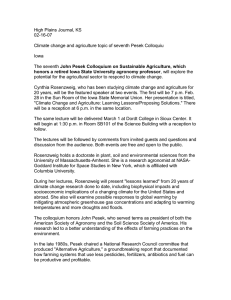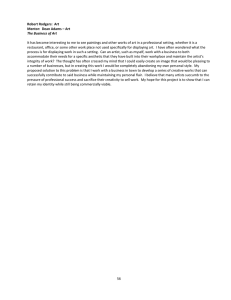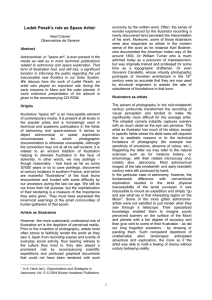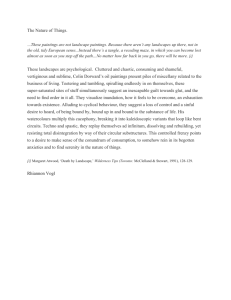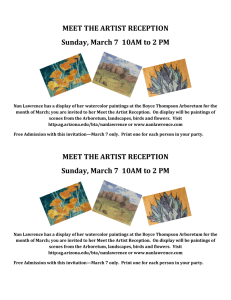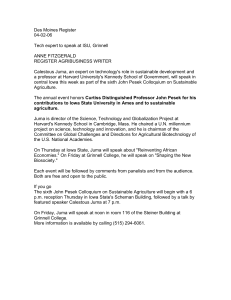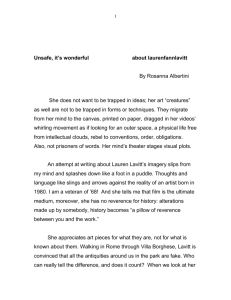The art of Ludek Pesek Introduction
advertisement
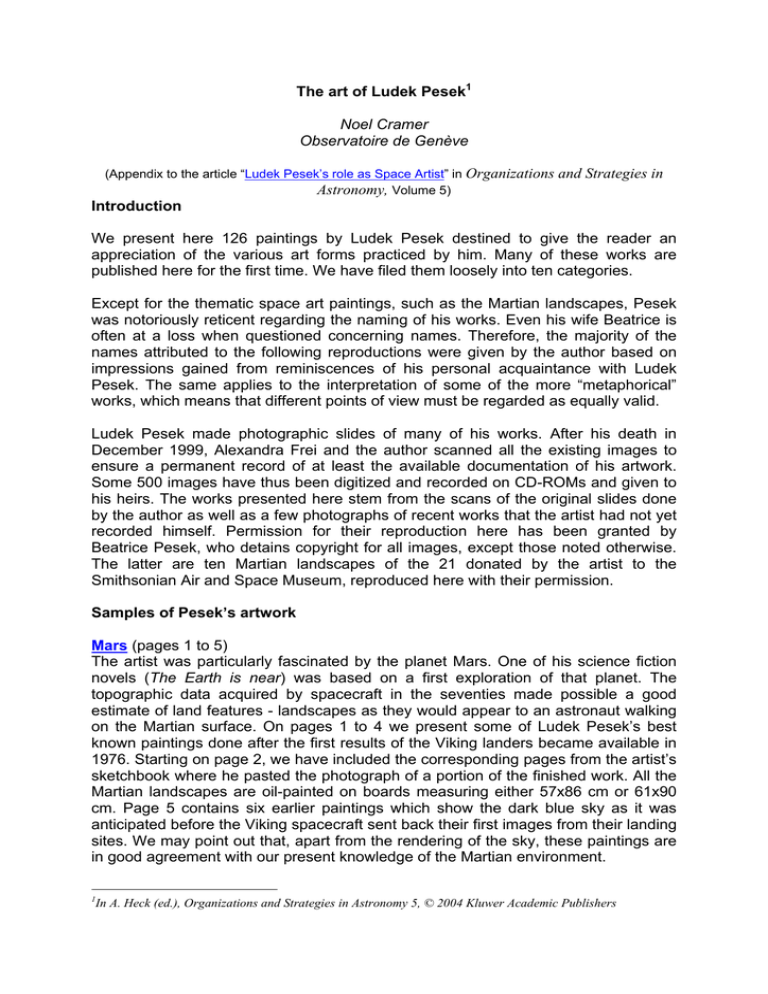
The art of Ludek Pesek1 Noel Cramer Observatoire de Genève (Appendix to the article “Ludek Pesek’s role as Space Artist” in Organizations and Strategies in Astronomy, Volume 5) Introduction We present here 126 paintings by Ludek Pesek destined to give the reader an appreciation of the various art forms practiced by him. Many of these works are published here for the first time. We have filed them loosely into ten categories. Except for the thematic space art paintings, such as the Martian landscapes, Pesek was notoriously reticent regarding the naming of his works. Even his wife Beatrice is often at a loss when questioned concerning names. Therefore, the majority of the names attributed to the following reproductions were given by the author based on impressions gained from reminiscences of his personal acquaintance with Ludek Pesek. The same applies to the interpretation of some of the more “metaphorical” works, which means that different points of view must be regarded as equally valid. Ludek Pesek made photographic slides of many of his works. After his death in December 1999, Alexandra Frei and the author scanned all the existing images to ensure a permanent record of at least the available documentation of his artwork. Some 500 images have thus been digitized and recorded on CD-ROMs and given to his heirs. The works presented here stem from the scans of the original slides done by the author as well as a few photographs of recent works that the artist had not yet recorded himself. Permission for their reproduction here has been granted by Beatrice Pesek, who detains copyright for all images, except those noted otherwise. The latter are ten Martian landscapes of the 21 donated by the artist to the Smithsonian Air and Space Museum, reproduced here with their permission. Samples of Pesek’s artwork Mars (pages 1 to 5) The artist was particularly fascinated by the planet Mars. One of his science fiction novels (The Earth is near) was based on a first exploration of that planet. The topographic data acquired by spacecraft in the seventies made possible a good estimate of land features - landscapes as they would appear to an astronaut walking on the Martian surface. On pages 1 to 4 we present some of Ludek Pesek’s best known paintings done after the first results of the Viking landers became available in 1976. Starting on page 2, we have included the corresponding pages from the artist’s sketchbook where he pasted the photograph of a portion of the finished work. All the Martian landscapes are oil-painted on boards measuring either 57x86 cm or 61x90 cm. Page 5 contains six earlier paintings which show the dark blue sky as it was anticipated before the Viking spacecraft sent back their first images from their landing sites. We may point out that, apart from the rendering of the sky, these paintings are in good agreement with our present knowledge of the Martian environment. 1 In A. Heck (ed.), Organizations and Strategies in Astronomy 5, © 2004 Kluwer Academic Publishers Rings (pages 6 and 7) Saturn, Jupiter, Uranus, and some of their satellites. The first two images on page 6 are variants of the series of views in Saturn’s rings mentioned in the main text. Dreams (pages 8 to 11) A selection of 24 “metaphorical” or “surrealistic–poetic” works, as the artist used to call them. Cosmic elements are almost always present. The first three “Transformation” paintings exploit conflicting visions of a landscape using a same basic template and were painted at different periods of the artist’s life as can be seen from the evolution of their technical rendering. The last three images on page 9 make use of definitely classical backgrounds to enhance the unexpected allegory of a floating timepiece reflecting, maybe, the gradual erosion of the mountain landscape by time; of a violin growing out of a tree symbolising harmony in nature or of an axe planted into a dead tree though carrying the promise of life by sprouting leaves from its handle. The first two images on page 10 can be perceived as jests due to their paradoxical nature. The one we have named “The lure of the apple” is probably the most densely symbolic of Pesek’s known works. Using multiple metaphors via its depiction of “dubious virginity” associated with symbols of both hope and despondency, it is very different from the more explicit suggestion of “tyranny” in the next work. Escape (page 12) These six works symbolise in different manners the escape from confinement. This is achieved either by the revelation of vast horizons over a barrier or through an opening, or else by the physical act of escaping. Ruin (page 13) The six works on this page suggest “ruin” in different manners. The first four explicitly depict ruins and desertification, though the yardsticks in two of them may imply hope of restoration. The last two, rather disquieting images, could be interpreted as the ruination of life by the hunter, or by the esoteric “crucifixion” of a swallow. Variations (pages 14 and 15) The twelve paintings in this section show the use of similar motifs in different contexts. The same “trompe l’oeil” frames of the first two paintings. The identical walls of a mountain pasture serving in the second work as the forlorn surroundings of a frightened and abandoned teddy bear. Or a beautiful country landscape that takes on a sinister aspect with the addition of a knotted cord and bizarre amulet. We may also mention the “saintly” figure growing out of a tree trunk and whose figure, in the second painting, seems to express anxiety as his temple, or church, is dismantled and swallowed up by the cosmos. Cold War (page 16) These are some of Pesek’s works done during the early phases of the “cold war” between the Soviet Union and the West. They use moon landscapes as settings to symbolise various aspects of militarily enforced tyranny. For instance, a crater serving to enclose the cemetery of a prison camp, or to provide the amphitheatre for the audience at a hearing of an individual facing overwhelming power. The “military” discus thrower, who seems to be on the point of casting away the Earth, evokes the threat of nuclear conflict and its worldwide devastating consequences that was ever present in the collective perception of that time. Triptycha (pages 17 and 18) Ludek Pesek painted a series of large (almost 3 m wide) triptychs in his later years. Homage to Magritte was done in the nineties following a visit by the artist to a Magritte exhibition in Paris. The leopard on the Kilimanjaro was inspired by the story of the frozen leopard discovered near the summit of the mountain in 1926 by the Pastor Richard Reusch, and immortalised in the introduction to Hemingway’s Snows of Kilimanjaro. Forest (page 19) Six of the 50 American West Coast forest scenes painted during the artist’s stay in the United States. They are a perfect example of his formal education in classical naturalistic techniques. Classic (pages 20 to 22) The first fourteen works are also purely classical landscapes. The second Zürich painting is rendered in an impressionistic manner. The “House in the Beskidy Mountains” is a reminiscence of Pesek’s childhood. The one named “A long way to go” is one of Ludek Pesek’s last works and was presented to the author and his wife in August 1999. As he said, he had “chiselled” their initials onto a rock lying beside the path…. The last four are abstract compositions, though the last one is decidedly less so and may be considered as a humorous rendering of the preceding one. Noel Cramer
